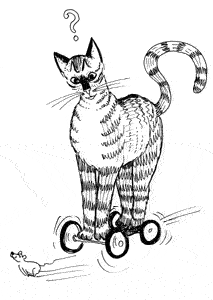STRANGE BUT TRUE- Wheelies: Why no rolling rhinos?
Published January 5, 2006 in issue 0501 of the Hook
BY BILL SONES AND RICH SONES, PH.D.

DRAWING BY DEBORAH DERR McCLINTOCK
Q. Animal engineering: echo-ranging by bats, dams built by beavers, parabolic reflectors of limpets, infrared heat-seeking sensors in some snakes, the hypodermic syringe of wasps and snakes and scorpions, the harpoon of cnidarians and jet propulsion by squids. More could be cited, but not the wheel, that proverbial human invention. Why not? --M. Perkins
A. Ship and airplane propellers, spinning drills, lathes, potters' wheels--our technology runs on the wheel, which may have been invented in Mesopotamia some 6000 years ago, says Richard Dawkins in The Ancestor's Tale.
Perhaps most animals wouldn't benefit from wheels because they already run so fast on legs. And a large animal would need large wheels, grown "in situ" rather than separately fashioned out of dead materials, then mounted.
"The problem of supplying a freely rotating organ with blood vessels and nerves that don't tie themselves in knots is too vivid to need spelling out. There might be a solution, but we need not be surprised that it has not been found.
Lastly, for best efficiency, a wheel needs a prior invention-- the road. Even a car won't beat a horse in wild country or plowed fields, with hedges or ditches in the way. But for a species to build a road requires altruism, working on something that will benefit others but not necessarily themselves-- something no other large animals do.
Q. What's the hippest, tekkiest device on your car? --E. Ford
A. Throttle-by-wire is one candidate, already on the Mustang GT and many others, which surprises people because here the gas pedal connects only to a sensor and spring that makes it feel like an old-style throttle cable, but it isn't, says Stanford professor of mechanical engineering J. Christian Gerdes. Instead, the sensor communicates the driver's commands to a small motor that opens the throttle electronically with no mechanical link. Throttle-by-wire today is becoming the standard. "Most people don't realize that the pedal they are pushing on isn't mechanically doing anything!"
As for things that could be on cars, GPS (global positioning system) receivers can give a car's speed over ground to an accuracy of a few centimeters per second, based on radio signals received from a constellation of satellites. Since a car's tires deform when the car accelerates and decelerates, the GPS measurement is actually more accurate than the wheel speeds at measuring vehicle speed.
The tiny difference between these speeds is known as "tire slip" and is a strong function of inflation pressure, detectable via GPS to an accuracy on the order of a psi or
2. "As my mom put it, 'Do you mean to tell me that satellites orbiting the earth can measure my car's speed better than sensors on the wheels?' Exactly."
Q. Is medical science beginning to understand the "miracle" of how the body heals itself?-- J.D. Aller
A. Great strides have been made in the field of "cell signaling," regarding how cells interact with the rest of the body and communicate with other cells using various biochemical signals, says Penn's Aron B. Fisher. For example, where an injury or wound impedes the local flow of blood, the endothelial cells respond by activating enzymes to produce nitric oxide, which dilates the blood vessels and aids cellular proliferation.
With time, the body in its "ancient wisdom" is able to restore normal blood flow. "While much has been learned, much is yet unknown. Pharmaceutical scientists are working to develop effective agents to lend the body an assist."
But those same signals that heal and that are normally present during embryonic development can go wrong when a person develops diseases such as cancer or liver cirrhosis, says Wendy M. Mars, PhD, with the University of Pittsburgh's Department of Pathology. In fact, liver cirrhosis is essentially just scarring of the liver tissue, and when the scar becomes too prominent, normal liver functions are lost.
The un-miracle of healing run amuck.
Send Strange questions to brothers Bill and Rich at .
#
|